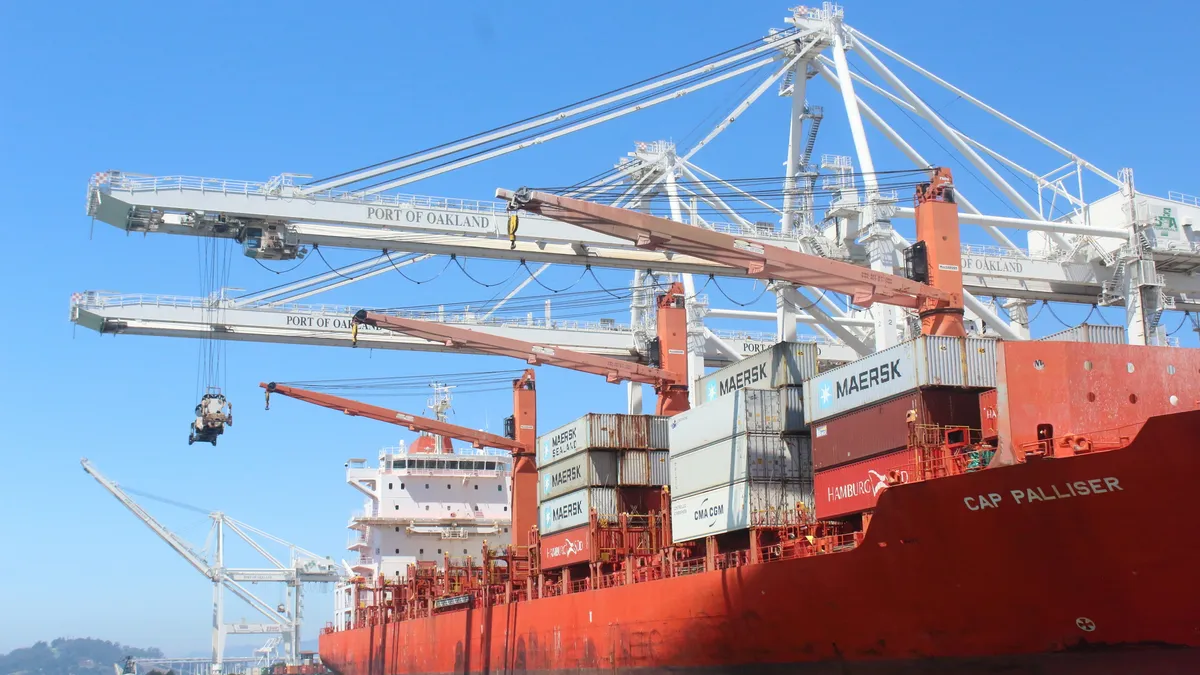Dive Brief:
- Record growth at the Port of Oakland may not last past January, if the effects of tit-for-tat tariffs set in during 2019, the port said in a press release reviewing a meeting of its Efficiency Task Force.
- The Task Force said West Coast imports are growing at an unprecedented level, causing warehouses to fill up and shipping lines to add more than 30 Transpacific voyages to transport large volumes. The surge is due to a strong economy and peak season, but could also be because of "frontloading."
- "Imports are a good story, but the reason for the growth is still something of a mystery," Port of Oakland Maritime Director John Driscoll said in a statement. "We suspect frontloading is part of the answer."
Dive Insight:
Frontloading has been a part of the tariff conversation since the summer, but its effects remain far from clear.
At the onset of the first few rounds of tariffs — on steel and aluminum and $50 billion worth of Chinese goods — analysts predicted ports would see peak season come early, as retailers rushed to import goods before the tariffs set in. July and August were indeed record months, according to port data, but retail imports never peaked.
By contrast, even as the third, and so far largest, round of tariffs on $200 billion worth of Chinese goods entered force on Sept. 24, imports from China continued to surge. In October, China exported $42.7 billion worth of goods to the United States — a 13.3% annual increase.
"Front-loading export activities should continue in November and December," Iris Pang, economist with ING, wrote in an analysis. "Export growth data will continue to be stronger than in previous holiday seasons."
But what the Port of Oakland Efficiency Task Force wanted to know is: for how long? Strong trade, warehouse and vessel utilization is good for supply chain stakeholders, but could it come with a sting in the form of a severe drop in 2019?
The Port of Oakland has in recent months been hit hard by shifts in trade rules, as China attempts to limit imports of wastepaper below a certain grade. The port said while its import volume from China was up 5% over 2017, its exports to China had fallen 33% in 2018.
China has been cracking down on imports of scrap from the U.S. since at least November 2017, affecting not just wastepaper, but at least 30 other export categories. With over a year to settle into the new rules of trade, supply chains have adapted, shifting their networks to include countries like Vietnam, Indonesia and India.
The wastepaper experience sheds light on how changes to import rules may ultimately alter sourcing networks, and therefore port and container volumes.
In that sense, supply chain stakeholders — like land-side trucking companies, warehouses and ports — have the most to lose if the import surge in 2018 turns out to be a red herring of growth, and instead becomes a forefather to general volume declines.
Meanwhile, one group of stakeholders appears to be benefiting from the temporary tariff situation: ocean shipping lines. In a note, titled, "Thank You, Mr. President?", Drewry Maritime Consultants wrote that Transpacific trade is again a "money printing factory for carriers."
An import surge has led to higher rates and full ships, a good trend for carriers. "A lot of the sudden cargo rush was attributed to US President Donald Trump's imposition on a whole range of Chinese goods, which came into effect 24 September and spurred American importers to bring forward supplies," the analysts wrote.
Correction: A previous version of this article misidentified the tactics used by China to limit wastepaper imports.















